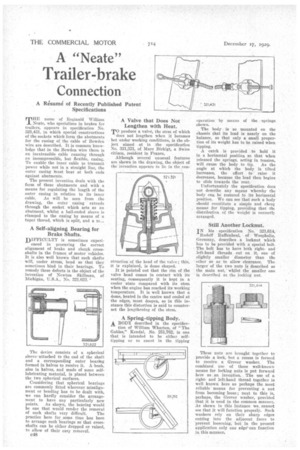"Neate"
Page 70

If you've noticed an error in this article please click here to report it so we can fix it.
Trailer-brake
Connection
A Resume of Recently Published Patent Specifications THE name of Reginald William Neste, who specializes in brakes for trailers, appears in specification No. 321,431, in which special constructions of the sockets which form the abutments for the casing of the cable of Bowden wire are described. It is common knowledge that in the Bowden wire there is an inextensible cable running through an incompressible, but flexible, casing. To enable the inner cable to transmit • power while not in a straight line, the outer casing Must bear at both ends against abutments,
The present invention deals with the form of these abutments and with a means for regulating the length of the outer casing in relation to its inner cable. As will be seen from . the drawing, the outer casing extends through the socket which acts as an abutment, whilst a ball-ended sleeve is clamped to the easing by means of a taper thread, which is split, and a nt
A Self-aligning Bearing for Brake Shafts.
DIFFICULTY is sometimes experi enced in procuring the correct alignment of brake and clutch crossshafts in the frames of motor vehicles. It is also well known that such shafts will, under stress; bend so that they sometimes bind in their bearings. To remedy these defects is the object of the invention of Newton Skillman, of Michigan, No. 321,622.
The device consists of a spherical sleeve. attached to the end of the shaft and a corresponding outer bearing formed in halves to receive it. A bush, also in halves, and made of some selflubricating material, is placed between the two spherical surfaces.
Considering that spherical bearings are commonly fitted wherever misalignment or bending has to be dealt with, we can hardly consider the arrangement to have any particularly new points. As shown, the bearing would be one that would render the removal of such shafts very difficult. The practice here for some time has been to arrange such bearings so that crossshafts can be either dropped or raised, to allow of their easy removal.
c48
• A Valve that Does Not • Lengthen with Heat.
TO produce a valve, the stem of which does not lengthen when it becomes hot under working conditions, is the object aimed at in the specification No. 321,321, of Marc Birkigt, a Swiss citizen, resident in France.
Although several unusual features are shown in the drawing, the object of the invention appears to lie in the con struction of the head of the valve ; this, it is explained, is dome shaped.
It is pointed out that the rim of the valve head comes in contact with its seating, consequently it is kept in a cooler state compared with its stem when the engine has reached its working temperature. It is well known that a dome, heated in the centre and cooled at the edges, must deepen, so in this instance this distortion is said to counteract the lengthening of the stem.
A Spring-tipping Body. A BODY described in the specifics
tion of William Wharton, of "The Gables," Kendal, No. 251,762, is one that is intended to be either selftipping or to assist in the tipping operation by means of the springs shown.
The body is so mounted on the chassis that its load is nearly on the balance, so that only a small proportion of its weight has to be raised when tipping.
A catch is provided to hold it in a horizontal position so that when released the springs, acting in tension, will cause the body to tip. As the angle at which the body is tilted increases, the effort to raise it decreases, because the load then begins to slide towards the rear.
Unfortunately the specification does not describe any means whereby the body can be restored to its horizontal position. We can see that such a body should constitute a simple and cheer means for tipping, providing that tin distribution of the weight is correct13 arranged.
Still Another Locknut.
IN his specification No. 321,614,
Rudolf Rafflenbeul, of Wesphttlia, Germany, describes a locknut which has to be provided with a special bolt. The bolt has to have both rightand left-band threads cut on it, one of slightly smaller diameter than the other so as to allow clearance. The larger of the two nuts is described as the main nut, whilst the smaller one is described as the locking mit.
These nuts are brought together to provide a lock, hnt a recess is formed to receive a Grover washer. The combined use of these well-known means for locking nuts is put forward here as . an invention. The use of a rightand left-hand thread together is well known here as perhaps the most reliable means for preventing a nut from becoming loose.; next to this is, perhaps, the Grover -washer, provided that it is used in the common manner. As shown in this instance we, cannot see that it will function properly. Such washers rely on their sharp edges cutting into the adjacent faces to prevent loosening, but in the present application only one edge` can function in this manner.












































































































